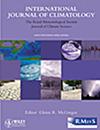摘要
本研究利用 30 年来的 NCEP/NCAR 冬季(1 月)再分析数据和中国气象局(CMA)的日降水量数据,采用客观识别方法将南支槽(SBT)划分为东部和西部类型。随后,分析确定了每种类型的结构特征,并评估了它们对降水的影响。研究结果表明,东部和西部 SBT 位于 500 hPa 的不同坐标,各自影响不同的降水区域。具体来说,东部 SBT 影响东经 90° 以东地区,尤其是云南,而西部 SBT 主要影响东经 90° 以西地区,对西藏南部影响明显。动力学分析表明,两种类型的 SBT 都表现为气压槽,但西部类型比东部类型表现出更强的动力学条件。两种 SBT 的特点都是槽前有温暖湿润的对流,槽后有寒冷干燥的对流。东部 SBT 比西部 SBT 表现出更有利的热力条件。与这两种 SBT 相关的水蒸气都集中在 450 hPa 以下的低槽前部,并在 700 hPa 以下出现辐合。此外,与西部 SBT 相比,东部 SBT 产生的水汽辐合更为明显。值得注意的是,与东部 SBTs 有关的暴雨降水是由来自西太平洋副热带高压外围环流的水汽以及来自孟加拉湾的额外水汽驱动的。相比之下,与西部 SBT 有关的水蒸气主要来自阿拉伯海,并得到孟加拉湾水汽的补充。Using 30 years of NCEP/NCAR reanalysis data from winter (January), along with daily precipitation data from the China Meteorological Administration (CMA), this study employed an objective recognition method to classify southern branch troughs (SBTs) into eastern and western types. Subsequently, an analysis was conducted to identify the structural characteristics of each type and evaluate their effects on precipitation. The findings reveal that the eastern and western SBTs are located at different coordinates at 500 hPa, each affecting distinct precipitation zones. Specifically, the eastern SBT influences regions east of 90° E, particularly Yunnan, while the western SBT primarily impacts areas west of 90° E, with a pronounced effect on southern Tibet. Dynamic analysis indicates that both types of SBTs manifest as baroclinic troughs, though the western type exhibits stronger dynamic conditions than the eastern type. Both SBTs types are characterised by warm, moist advection ahead of the trough and cold, dry advection behind it. The eastern SBT shows more favourable thermal conditions than the western SBTs. Water vapour associated with both types of SBTs is concentrated at the front of the troughs below 450 hPa, with convergence observed below 700 hPa. Additionally, the eastern SBTs generate more pronounced water vapour convergence compared to the western SBT. Notably, torrential precipitation related to the eastern SBTs is driven by water vapour from the outer circulation of the western Pacific subtropical high, with additional moisture from the Bay of Bengal. In contrast, the water vapour associated with the western SBT primarily originates from the Arabian Sea and is supplemented by moisture from the Bay of Bengal.

 求助内容:
求助内容: 应助结果提醒方式:
应助结果提醒方式:


